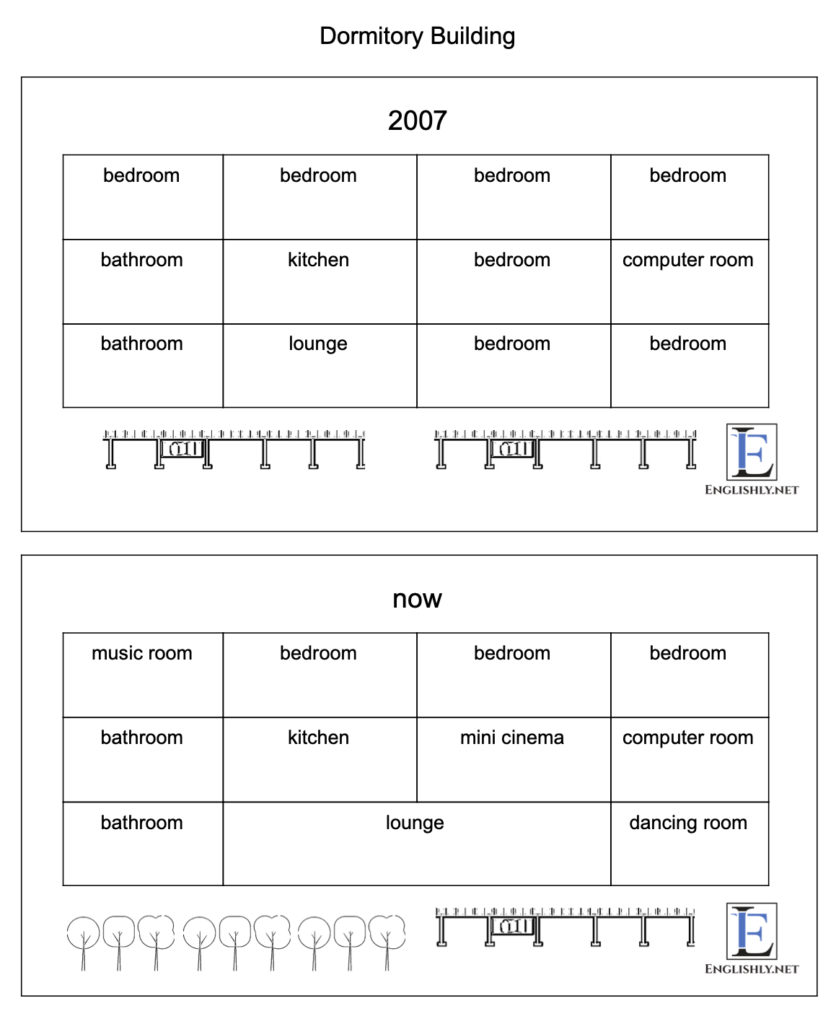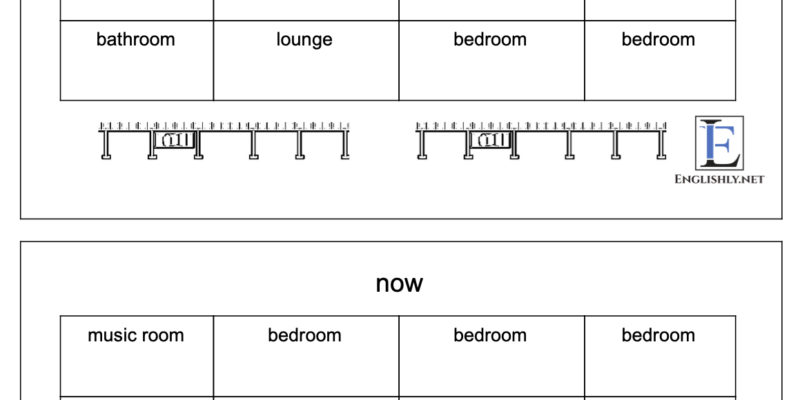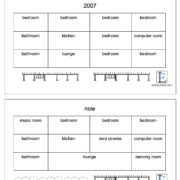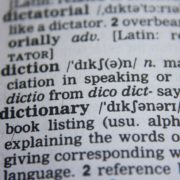You should spend about 20 minutes on this task.
The graphs below show the development of a dormitory building between 2007 and present.
Summarize the information by selecting and reporting the main features and make comparisons where relevant.
Write at least 150 words.

| Sample Response |
The floor plans compare the layouts of the student residence respectively in 2007 and the present, manifesting how the allocation of space in the building has changed. Overall, the rearrangement aims to achieve a lower residential density and is indicative of a higher emphasis on students’ recreational needs.
First, the redesigned student hostel is expected to accommodate a smaller residential population than in 2007. The number of bedchambers has decreased from 7 to 3, although the spaces allotted for bathing and cooking have remained unaltered. Also, half of the car park has been repurposed as a garden, making the number of parking slots available drop from 10 to 5.
Next, the changes to the purposes of the rooms exhibit a higher level of importance apportioned to leisure activities compared to the original plan. Three of the dormitory rooms in the 2007 layout have been redesignated as a music room, a small movie theater, and a dancing room. The current lounge is also an extended one, built by combining the old lounge area and its adjacent bedroom, as shown in the 2007 schematic, with the removal of the wall in-between.
In sum, the area for accommodation purposes has been reduced and the idle space has been reused to cater to residents’ needs for entertainment.
Word count: 213
| Analysis |
What this criterion means
Show ExplanationTruth be told, Task Achievement is indeed the most difficult criterion for the majority of IELTS takers to score well on. One of the main reasons is that the official band descriptors are phrased in language that lacks clarity (e.g., a “fully developed response” and “all the requirements”). Students who follow (too) closely what the band descriptors say are oftentimes unaware of what exactly examiners are looking for in this respect — analysis.
Analysis refers to an in-depth examination of something that reveals its nature or essential features through breaking down and reorganizing its original parts. Hence, to achieve a high score on this grading criterion, simply listing every feature one by one in writing is insufficient. The ideal candidate will also need to identify the message or the theme hidden in the data and provide a succinct explanation with supportive evidence.
In this task of comparison and contrast, the agenda is to correctly pinpoint two underlying but salient features, namely lower residential density and a higher emphasis on recreation. The former, which means fewer occupants sharing the same living area, can be deduced from the decreased numbers of bedrooms (from 7 to 3) and parking spaces (from 10 to 5). The latter, which refers to provision of more facilities for entertainment, is evidenced by unused spaces having been repurposed as rooms that fulfil recreational needs (i.e., a bigger lounge, a music room, a mini movie theater, and a dancing room).
Not only does the writer pinpoint the rationales behind the rearrangement of the rooms and provide accurate evidence, he or she also supplies details that are not directly relevant as points of comparison (e.g., “although the spaces allotted for bathing and cooking have remained unaltered”). By including additional information, the writer has provided a fuller picture.
What this criterion means
Show ExplanationCoherence and cohesion are technical terms in linguistics. Their meanings are quite similar indeed, so people may get thrown off when they first encounter those two concepts. Both meaning how well words can form a unified text, coherence focuses on logic and cohesion is centered on use of language. Still befuddled? Take a look at this example: “I have three dogs. Dogs chew bones. Bones allow us to stand up and run.” These sentences are stringed together in a cohesive manner, with sentence endings closely aligned with sentence starters that follow. However, this short passage is not coherent at all, as it doesn’t make any sense.
Seven tips to achieve coherence and cohesion
While someone may contend that logic is an abstract concept that no one can put a finger on, there are indeed a few hands-on tips that can help you structure your essay in a logical way.
1) Draft an outline similar to this one and follow its structure.
2) Avoid writing short sentences (e.g., sentences less than 6 words).
3) Use linking phrases such as “next,” “in addition,” “moreover,” and “furthermore.”
4) Use words that introduce contrast. Examples include “however,” “although,” “but,” “in contrast, ” as well as comparative (e.g., higher) and superlative adjectives (e.g., the highest).
5) Repeat what you have said without using the same words. Methods include using synonyms and changing word forms (e.g., “smokers” and “people who smoke”)
6) Make sure a sentence begins with a phrase that can connect to the first phrase of the previous sentence.
7) For each paragraph, start with a topic sentence, which provides a general overview of the arguments and evidence you are going to present.
This writing sample shows a clear and well-organized structure that is easy to follow: The first paragraph provides background information and introduces the two key features in the writer’s analysis (i.e., lower residential density and a higher emphasis on recreation). The two body paragraphs that follow both begin with a clear topic sentence, and pieces of supportive evidence are put together logically with the help of appropriate linking phrases that show the relationships between them. Examples include the use of comparative adjectives (e.g., “to accommodate a smaller residential population than in 2007″) and linking words (e.g., “The number of bedchambers has decreased from 7 to 3, although the spaces allotted for bathing and cooking have remained unaltered.”).
What this criterion means
Show ExplanationThis criterion is probably the easiest to understand and explain. A closer look at the official band descriptors offers some helpful directions. They basically touch on these aspects related to use of vocabulary:
Range of vocabulary: how many synonyms you can include to substitute for each key concept (e.g., the synonyms for “job” include “occupation,” “work,” “profession,” “industry,” “trade,” “employment,” and “career.”)
Control of lexical features: whether you can attach affixes to words to change or refine their meanings (e.g., an anti-racist workplace, cringe-inducing, and culture-wise)
Uncommon lexical items: how many infrequent/ advanced / technical words you use (e.g., “recluse” instead of “loner,” and “refuse” instead of “rubbish”)
Word choice: whether your use of vocabulary fits the sentences, contexts, tone, and the text type and conveys accurate meanings (e.g., someone who fell down on the street and started bleeding = “injured,” not “sick”)
Collocation: whether the words you use to form a phrase are supposed to be put next to each other (e.g., “do some changes to the regulations = wrong. The right verb that goes together with “some changes” should be “make.”)
The author uses a wide gamut of synonyms for each main concept. Examples include those related to “floor plans” (e.g., “layouts,” “plans,” and “schematic”), “dormitory” (e.g., “student residence” and “student hostel”) as well as “decrease” (e.g., “drop,” “reduce,” “lower,” and “smaller”). There are also instances where the prefix “re” is used to alter the meanings of words to form synonyms for “change” (e.g., “rearrangement,” “[un]altered,” “redesigned,” and “repurposed.”). HIs or her use of lexis also involves technical vocabulary items (e.g., “adjacent,” “schematic,” and “removal”) that are related to the field of architecture, indicating understanding of the task as well as knowledge of industry-specific language use.
What this criterion means
Show ExplanationGrammar seems to a borderless area that covers a wide spectrum of topics and concepts. Indeed it is, but IELTS band descriptors indicates a rather narrow view. Pay attention to the first descriptor under “Grammatical Range and Accuracy” for “Band 6” which reads “uses a mix of simple and complex sentence forms.” What’s so special about that statement? If you take a look at the same descriptor for the bands above 6, you see that the word “simple” is no longer there. This means, to achieve a score above 6, you need to write (almost) every single sentence in complex sentence form on top of presenting accurate use of grammar. Of course grammatical accuracies are also important to getting a high score.
Among the four criteria, the grammatical aspect of this writing is probably the weakest. Although the author did use complex sentences (e.g., The number of bedchambers has decreased . . . , although the spaces allotted for . . . . ), the frequency is not satisfactory. The author should think about how he or she can change simple or compound sentences into the complex form whenever possible. Take the last sentence as an example, its syntactic complexity can be enhanced simply by adding a few words:
“In sum, (after the renovation was completed,) the area for accommodation purposes has been [was] reduced and the idle space has been [was] reused to cater to residents’ needs for entertainment. ”







Comments